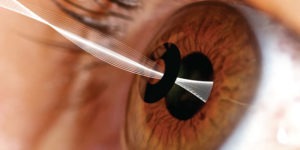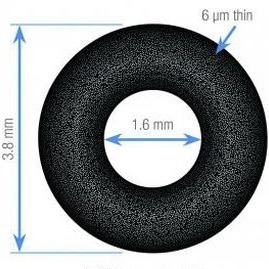[typeform_embed type="popup" url="https://relevantlab.typeform.com/to/NjV9Qd" button_text="Find my solution (Self Test)"]

[typeform_embed type="popup" url="https://relevantlab.typeform.com/to/NjV9Qd" button_text="Find my solution (Self Test)"]
The goal of the corneal inlay procedure is to improve near vision for people that have good distance vision but need over-the-counter reading glasses for close work. The corneal inlay procedure is intended for people between the ages of 40-60 years old with otherwise normal healthy eyes. What makes corneal inlays unique from previous “near vision” procedures is that the inlay can maintain good binocular distance vision, too.
 How much time do you spend wearing readers for viewing your cell phone, tablet or laptop?
How much time do you spend wearing readers for viewing your cell phone, tablet or laptop?
Similar to LASIK, the corneal inlay procedure is a painless blade-free procedure that takes a total of about 10 minutes to complete. First, the surgeon uses a femtosecond laser (same laser used for All-Laser LASIK) to create a “LASIK flap or pocket” within the cornea of the non-dominant eye. Next, the corneal inlay is positioned and centered within the cornea to complete the procedure.
Most patients can see “at least 20/25” at ALL distances (near, intermediate and far) after the inlay procedure without ANY glasses. The unique design of the corneal inlay allows near vision to be improved while retaining good binocular depth perception and stereo vision. For peace of mind, it’s reassuring to know that a corneal inlay could be easily removed, if desired, and one could just go back to wearing their previous reading glasses.
The KAMRA corneal inlay (images below) is based on a simple optical concept known as the “pinhole effect” to increase one’s depth of focus and improve one’s near vision focus, much like the f-stop function of a camera aperture.


Around the age of 40-45, our near vision gradually begins to worsen as the natural lens of the eye becomes less flexible and unable to focus for near work. This process is called Presbyopia. Most people become dependent on reading glasses or bifocals to see objects within arm’s reach. For people that don’t want to hassle with reading glasses, the corneal inlay procedure is an FDA-approved procedure that can help. Based on each patient’s unique scenario, we will be able to determine if a corneal inlay or laser vision correction is most appropriate.
Typically, the treated eye will feel slightly irritated or “scratchy” and vision is usually slightly blurry during the first few days of healing. Typically, patients are fine to return to work the next day. It is important to use lubrication eye drops, antibiotic drops and and anti-inflammatory drops during the first couple of months of the recovery period. Though the initial recovery period is quite quick, it takes about 3 months for final results to be 100% complete with the corneal inlay procedure, as is similar with LASIK.
The initial prototypes for the corneal inlay have been evolving for many decades. The KAMRA inlay has been used worldwide since 2003. After several technical refinements and long term studies, the KAMRA inlay became the first corneal inlay to be granted FDA approval in 2015. The KAMRA inlay works well in patients with slight nearsightedness and can often be performed in patients that have had previous LASIK.
Are corneal inlays cosmetically visible to others?

The KAMRA Inlay (right eye of above photo) looks similar to one’s black pupil. To the unaided eye, it is difficult to notice the KAMRA cosmetically, but it may be able to be “seen” with close inspection with bright lighting.
As with any medical procedure, there are risks with corneal inlay. Fortunately, the corneal inlay is removable if there is a problem. Like LASIK procedures, it is very common to notice eye dryness or night vision halos, which typically normalize between 1-3 months after the procedure. There is a 1:10,000 chance of an infection, which is also similar to LASIK. Anti-inflammatory eye drops have an important role in minimizing post-operative inflammation because excessive inflammation could cause for removing the corneal inlay. So, it is important to use lubricating eye drops, antibiotic eye drops, and anti-inflammatory eye drops after the procedure to minimize each of these issues.
Corneal inlays and LASIK are able to treat different types of focusing problems. The corneal inlay is intended specifically for people that have good distance vision, but solely use over-the-counter reading glasses due to an age-related condition, called presbyopia. LASIK is intended for people that wear prescription glasses or contacts to correct nearsightedness, farsightedness and astigmatism. While LASIK can routinely achieve “20/20 distance vision”, LASIK patients will usually require reading glasses beyond age 45 due to presbyopia. LASIK patients that are beyond age 40 often choose “LASIK with Blended Vision/Monovision” (one eye for distance, one eye for near”) for better near vision after LASIK. Also, patients may consider LASIK Monovision if they already have good distance vision but are trying to not depend on over-the-counter reading glasses for near. For more info, read: “Should I do Full Distance LASIK or Monovision?”
606 Saratoga Ave,
San Jose, CA 95129
5790 Stoneridge Mall Rd, Pleasanton, CA 94588